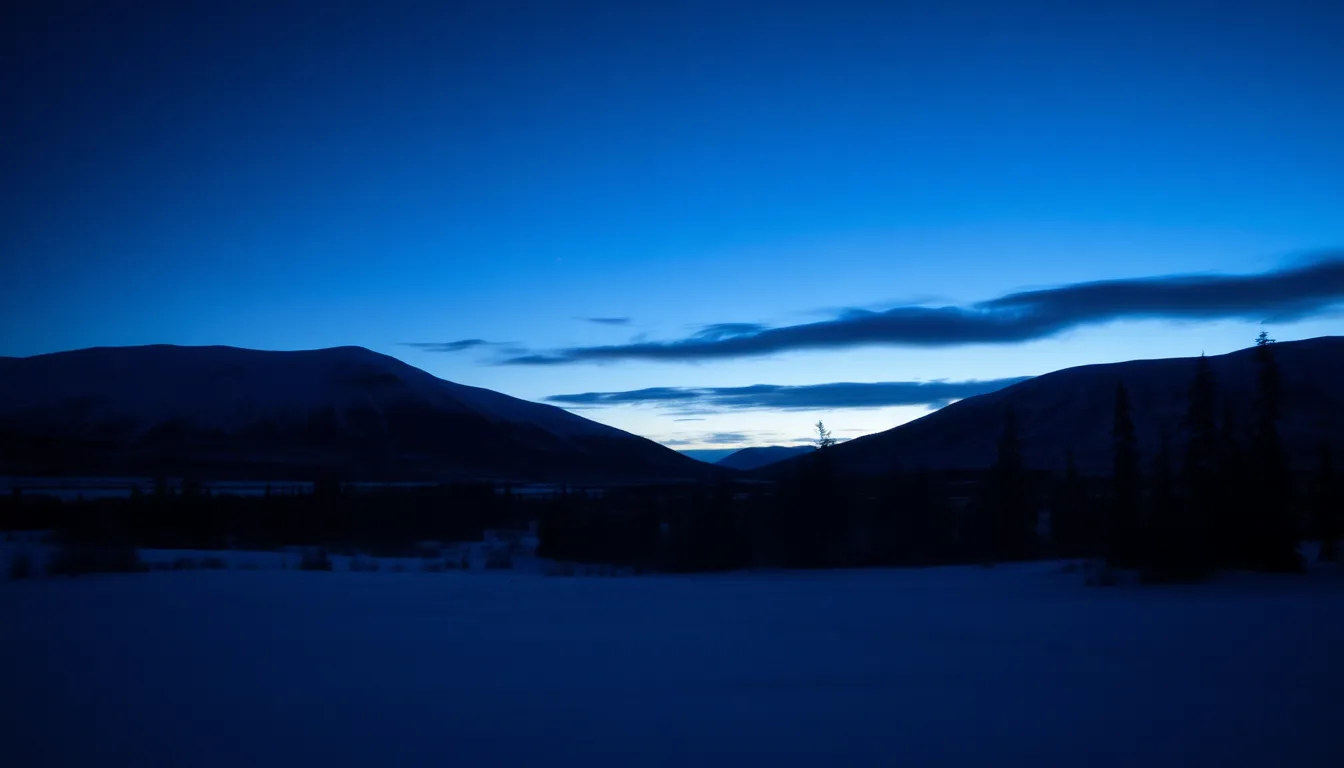Alaska is known for its breathtaking landscapes and wild adventures, but it’s also famous for its extreme daylight patterns. Ever wondered how long it’s dark up there? Buckle up because this isn’t just a simple question; it’s a journey into the land of the midnight sun and polar nights.
Table of Contents
ToggleUnderstanding Alaska’s Unique Daylight Cycle
Alaska experiences extreme variations in daylight, influenced by its geographic location and seasonal changes. These unique patterns create fascinating phenomena like the midnight sun and polar nights.
Geographic Location and Its Impact
Alaska’s position near the Arctic Circle significantly affects its daylight cycle. This proximity causes prolonged periods of light in summer and darkness in winter. Locations above the Arctic Circle, such as Barrow, experience continuous daylight for up to 84 days during summer. Conversely, in winter, these areas face up to 67 days of darkness. Its geographic features, including mountains and valleys, also influence how light penetrates certain regions. Daily light levels can vary depending on elevation and surrounding geography.
Seasonal Variations in Daylight
Every season presents distinct daylight patterns across Alaska. Summer months witness the phenomenon known as the midnight sun, with the sun remaining above the horizon for extended hours. During June, regions like Fairbanks receive about 22 hours of sunlight daily. Winter, however, brings the opposite effect, where daylight hours decrease drastically. In December, northern regions can see only a few hours of twilight. Anchorage experiences roughly five hours of daylight during this month. Seasons dictate not just light duration but also the activities available to residents and visitors alike.
The Science Behind Polar Night


Alaska experiences polar night, a phenomenon characterized by extended periods of darkness. It occurs primarily in the winter months, influenced by the state’s location above the Arctic Circle.
Definition of Polar Night
Polar night refers to the continuous darkness experienced in regions located near the poles. Above the Arctic Circle, the sun does not rise above the horizon for a specific time during winter. In places like Barrow, Alaska, this darkness lasts for about 67 days, from late November to mid-January. During this time, twilight may appear, but direct sunlight remains absent. Such conditions create a unique environment that affects wildlife and human activities.
Duration of Darkness in Different Regions
Duration of darkness varies greatly across Alaska’s regions. Barrow, located at the northernmost point, experiences its longest period without sunlight, lasting roughly 67 days. Areas further south, like Fairbanks, have shorter dark periods, limited to a few hours of sunlight in December. While the varying latitudes of Alaskan cities result in different darkness durations, all regions above the Arctic Circle undergo polar night. Understanding these geographic differences highlights the diverse experiences of residents and wildlife during extreme winter conditions.
Experiences During Extended Darkness
Extended darkness in Alaska creates unique cultural and psychological experiences for residents. The long winters profoundly affect daily life.
Cultural Adaptations in Alaska
Culturally, Alaskans develop unique strategies to thrive during prolonged darkness. Communities embrace festivals that celebrate light, such as the Festival of Lights in Anchorage. People often gather for social events, fostering connections that counteract feelings of isolation. Additionally, traditional practices like crafting and storytelling provide creative outlets. Outdoor activities, though limited, include ice fishing and cozy gatherings, which strengthen community ties. Residents also utilize bright indoor lighting to combat seasonal affective disorder and enhance mood. Emphasis on self-care becomes essential, with locals engaging in hobbies like knitting or woodworking during dark months. Collectively, these adaptations help Alaskans maintain a sense of normalcy and community spirit throughout winter.
Psychological Effects of Limited Daylight
Limited daylight significantly impacts Alaskans’ mental health. Symptoms of seasonal affective disorder commonly arise, with individuals experiencing fatigue and mood fluctuations. Some people report feeling more withdrawn or lethargic during the darkest months. Strategies like regular exercise and exposure to artificial light help mitigate these effects. Local mental health services emphasize awareness and treatment, providing support for those affected. Many Alaskans turn to social support networks to cope, recognizing the importance of connecting with others. Understanding these psychological effects fosters a sense of resilience among residents. Overall, adapting to the darkness contributes to personal growth and community resilience in Alaska.
How Long Is It Dark in Alaska?
Alaska’s darkness varies significantly throughout the year. Major cities experience distinct patterns of daylight and darkness, especially those located above the Arctic Circle.
Specific Timeframes for Major Cities
In Barrow, darkness lasts approximately 67 days, beginning in late November and ending in mid-January. Anchorage, located further south, sees about five and a half hours of daylight in December. Fairbanks enjoys a shorter period of darkness, with around 3 hours of sunlight during the winter solstice. During the summer months, Fairbanks witnesses almost 24 hours of sunlight, while Barrow enjoys continuous daylight for roughly 84 days. These timeframes illustrate the extreme differences in daylight exposure experienced by Alaskans.
Factors Influencing Darkness Duration
Geographic location plays a crucial role in determining how long it stays dark. Proximity to the Arctic Circle directly impacts the duration of both daylight and darkness. Latitude affects sun elevation; cities further north experience more extreme variations. Seasonal shifts also contribute, as the tilt of the Earth’s axis changes sunlight angles throughout the year. Additionally, local topography can influence light availability, creating shadows that affect some areas more than others. Understanding these factors highlights the unique experiences of Alaskans during the winter months.










